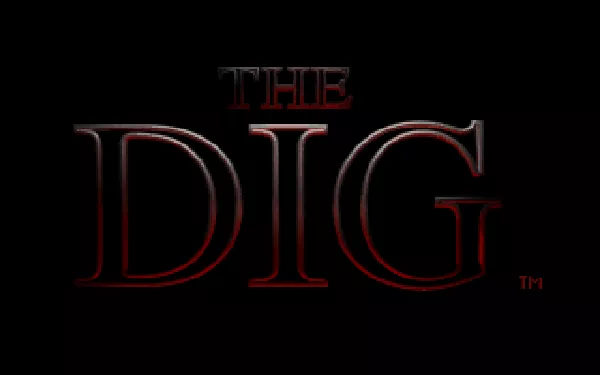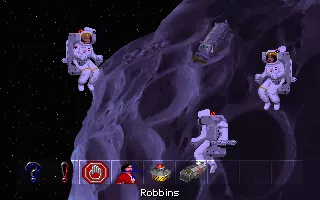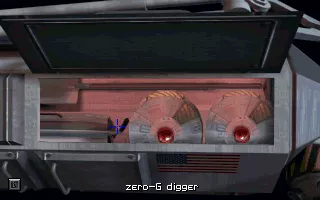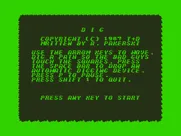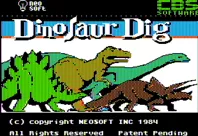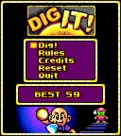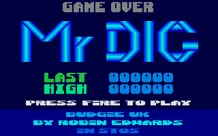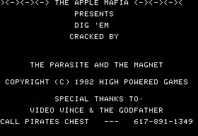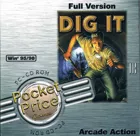The Dig
Description official descriptions
A group of scientists discovers an asteroid that is on its way to a collision with the Earth. Is there any way to prevent the disaster? Boston Low, a NASA veteran, is sent to command a space expedition on the asteroid. Accompanied by the journalist Maggie Robbins and the archaeologist Brink, Boston investigates the asteroid and finds a strange structure that undoubtedly belongs to an alien civilization. During the course of investigations, the team finds itself on a seemingly deserted planet. They have no knowledge of the planet and no possibility of going back. Will they ever discover the secret of this strange world and find a way to get home?
The Dig is a point-and-click adventure game with a simple one-cursor interface. Most of the puzzles are inventory-based, tending to be somewhat more complex than in most preceding LucasArts' adventure games. There are also a few logic-based puzzles, which require understanding and manipulation of alien technology and life forms on the planet. Traditional branching dialogue system is utilized; however, the game focuses more on puzzle-solving than on conversations to advance the plot.
The game's story is influenced by science fiction literature and movies, and strives to be realistic, departing from the comedy style of LucasArts' adventures. Despite that, humorous elements are present in some of the dialogues and text descriptions. The game utilizes hand-drawn graphics with a few pre-rendered 3D images.
Spellings
- 异星搜奇 - Simplified Chinese spelling
- 디그 - Korean spelling
Groups +
Screenshots
Promos
Credits (DOS version)
235 People (207 developers, 28 thanks) · View all
| Designed by | |
| Directed by | |
| Based on a Concept by | |
| Dialogue by | |
| Additional Story by | |
| Additional Additional Story by | |
| Art Style | |
| Creature Concept | |
| Lead Artist | |
| Background Art | |
| Supervising Animators | |
| Animators | |
| Special Effects Animators | |
| Additional Animation | |
| [ full credits ] | |
Reviews
Critics
Average score: 82% (based on 38 ratings)
Players
Average score: 3.9 out of 5 (based on 237 ratings with 21 reviews)
The Good
Dig is a real oddball among the fine creations of LucasArts. They made it when the golden age of comedy adventure was already gone, and the meditative, minimalistic techniques of Myst began to mesmerize people. This game is, in a way, a tribute to Myst done by developers whose previous work was associated with quite a different type of adventure design.
First things first: Dig has killer production values. I think it was supposed to be a movie at some point, and that really shows. Dramatic animated cutscenes, gorgeously drawn backgrounds, and a rich musical score complemented by perfectly placed sound effects immerse you as if you were in a cinema. You really feel you are lost in a gorgeous, but strange and possibly hostile alien world. A sense of wonder and grandeur permeates the exotic scenario.
The plot may not be the epitome of sci-fi storytelling, but there is something in the strange tale of a race that mysteriously vanished despite achievements like crystal-powered trams and immortality. Seriously, the game's story does deal with that latter issue - not the Abrahamic afterlife or the Indian reincarnation, but in the plainest sense of endless physical life reminiscent of primitive alchemy or Chinese Daoist searches for elixirs. You can play the game for yourself and discover the rather philosophical and certainly thought-provoking conclusion.
While Full Throttle could not combine cinematic treatment with challenging gameplay, Dig presents the most "hardcore" puzzle system LucasArts ever designed. If tough puzzles is your primary requirement for an adventure game, this one will be an excellent choice. The (in)famous turtle-reassembling puzzle is not alone in the constellation of hair-pulling tasks you'll have to face in this game. Prism-adjusting or critter-catching are just examples; the overall difficulty stems from the open nature of the game and the abundance of abstractly designed, in a certain way really "alien" mechanisms, where success depends on patience and persistence as much as it does on logical thinking and experimentation.
While Full Throttle was too short and too small (in terms of playable, explorable locations), Dig puts you into a large "hub" world that steadily grows as you solve puzzles and advance step-by-step. In fact, the game world itself is designed like a gigantic puzzle, since connecting the light bridges and gaining access to the planet's "inner sanctum" is one of the game's overarching tasks. The architecture of the game is pretty impressive, and at the very least you can feel that it was designed with a lot of thought and care.
The Bad
Ultimately, however, what matters most is whether the game is fun to play or not. Unfortunately - while I'm sure many will disagree - the experience of actually playing Dig is at best strenuous, and at worst tedious and awkwardly sterile.
The truth is that LucasArts were really out of their element in this one. They strove to beat Cyan at their own game, and they even got most of the tools right - but they weren't truly inspired to do that. Dig doesn't feel like a typical LucasArts product because it seems contrary to what its developers stood for. I may be grossly mistaken, but while I was playing the game I felt its creators didn't really want to make it - even though they obviously did a very solid, professional job.
There is no spark in the puzzles. In vain would we try to find here the wit and the elegance that has distinguished LucasArts' works. The few atypical (i.e. logical, observation-oriented) tasks such as for example the lens-retrieval early in the game were actually better than the more mundane inventory-based exercises LucasArts are usually so good at. Worse, those puzzles are often needlessly repetitive. It's okay to use a rod to open the door, but why is it necessary to have five rods to open five doors (and go through the same color- and shape- changing procedure), and a couple of rods which have nothing to do with the doors but are there just to cause more confusion?
One serious problem of Dig is its pacing. At first you feel awe-stricken at the sight of an exotic semi-abandoned alien world. You explore, solve tough puzzles, and rejoice when a new area opens up to you. But the more you play, the more you become entangled in the same type of activities - only the size of the game world grows, while the actual gameplay remains strikingly similar. There is no gradual building up to a climax, no diversion, no change of pace. Full Throttle had tiny linear areas we couldn't get attached to. Dig has a large hub that gets more and more boring as we explore it. Both games failed to capture the spirit of exploration the way other LucasArts' games did.
The difficulty of the puzzles in conjunction with an ever-growing world essentially means that the game largely consists of backtracking. After a while the monotony takes over completely. Throughout nearly the entire game, you'll be running back and forth through a lifeless world, fetching items and tinkering with rather unexciting alien mechanisms. Myst did it before, and frankly, it did it better, since its puzzles were more interesting. It even had a larger scenery variety, and that's saying a lot.
The emptiness of the world and the almost complete lack of characters to interact with would have worked for the introductory part. But you can't tell a compelling sci-fi tale with dead machinery and tiresome crystal-fixing. There must be some encounters, friendly or hostile, some dynamism and drama. Near the end of the game you finally get what you've been craving for - but it's too little and too late.
The Bottom Line
Dig is certainly LucasArts' most controversial, and generally least beloved adventure game. I've played through it two times, and my opinion fluctuated widely between the camps of the "haters" and the "redeemers", until I found myself assuming a middle position of sorts. There is surely a lot of quality stuff to be found in the game, and it is by no means the failure some people make it out to be. But in the end, your tender comedy-inclined hearts probably won't be able to favor majestic alien monotony and insane turtle puzzles over having a hippie design the American flag or telling your pirate opponent that he fights like a cow. They tried to catch the elusive soul of Myst, but lost the bright spirit of LucasArts in the process.
DOS · by Unicorn Lynx (181775) · 2014
The Good
This came out at an odd time for Lucasarts - after 'The Secret of Monkey Island 2' had been criticised for being too easy, they released this and 'Full Throttle', two solid adventures that, whilst pleasant enough, seemed to add little to the genre, and were not particularly hard. 'The Dig' is less cartoony and more 'serious' than their other games - it's a pulpy sci-fi adventure with the voice of Robert Patrick, the evil Terminator from 'Terminator 2'. It scores highly in terms of presentation - the animated intro is highly professional, and there's a constant, impressive score ('Wagnerian' according to the box) too.
The Bad
The puzzles veer from being utterly, utterly obscure (a sequence in which you manipulate a hovering drone in order to reactivate a power plant), to dull 'try every object with every other object' fests. Furthermore, what appeared to be a bug in my version of the the game rendered it unfinishable. Nonetheless, it's typically competent, and even when it's being dull there's the music to listen to.
The Bottom Line
Decent, solid adventure that won't tax you for more than a few days. With Robert Patrick!
DOS · by Ashley Pomeroy (225) · 2000
Don't get confused, The Dig is a TRUE classic
The Good
This is one of the last Lucas Arts's adventures that I had it left to play. Due to opinions and comments that I had read about it since long ago, I always thought perhaps it's not a great adventure. I imagined it was a good one, but not enough in order to consider it a classic. Well, my imagination (and much people) couldn't be more wrong: The Dig is amazing and should be an unforgettable classic. The key in The Dig is its atmospheric and intriguing story, unlike most of Lucas Arts's adventures, in which hilarious comedy and crazy-but-sidesplitting puzzles constitute their cores (Monkey Islands, Sam & Max, etc.). But The Dig has a gameplay with excellent puzzles and dialogues too…
In The Dig we take the role of Boston Low, a commander in charge of an expedition toward an asteroid which is on trajectory of collision with the Earth. Needless to say, all isn't what it seems to be, and together with his crew, the journalist Maggie Robbins and the geologist/archaeologist Dr. Ludger Brink, he initiates a fascinating adventure in a mysterious alien world. The story is full of surprises (but don't worry, I'm not going to reveal anything), and the involved-in-mystery ambience remains throughout the game. There is no moment to be bored. There are always something to explore, try and talk. Since the emphasis of the game is put in the story, and this, in turn, emphasizes the relationship between the protagonists, one would expect the dialogues offer more than some clues of puzzles and simple comments in order to "advance" through the plot: sure enough, the writers did a surprising job which surpasses any expectation. Conversations with our co-protagonist and thoughts of each one are excellently written, adding personality, emotion, humor and credibility to them and to the story. The adopted style for dialogues is similar to the one in George Lucas and Steven Spielberg's adventure movies such as Indy, and Jurassic Park, that is, with enough seriousness to be convincing in dramatic moments, but also with lots of funny and unconcerned comments in order to make the adventure relaxing and amusing, without to be a comedy. Although The Dig's tone is some more serious than above films (Indy, especially), I think they serve like an example. Besides, the whole storytelling looks like directed by Spielberg, and not only dialogues, so such movies should give you also a general idea of how is the story's unfolding in The Dig: astonishing at every instant!
The gameplay is as engrossing as its story. Although the game's mechanics is similar to other LucasArts's adventures (something good by itself), it's surprising how the designers accomplished that every action were truly an important and convincing part of the story. Puzzles are very diverse, and they require exploring, talking and combining items. They are challenging (but intuitive), clever and gratifying. There is no frustration; here, there is a story to tell first, by means of a perfectly integrated to the story and its world gameplay. "To play" The Dig is a pleasure.
The audio-video aspect is an essential part in The Dig: not only it helped to sell a few more copies, but also to create an atmosphere as immersive as very few games (independently genre and age) could reach. Its graphics are simply fabulous. The exquisitely illustrated and animated landscapes, characters' animations like cartoons, and the excellent cut-scenes join to make a cinematographic experience from beginning to end. Together with Full Throttle, The Dig originated the "movie style" in graphic adventures. Equally grandiose is the audio side. The entire game is enriched by an highest quality (artistic and technic) audio labor: clear-cut environmental sounds, characters' every action are recreated with proper sounds, etc. Continuing with "cinematographic experience", the speech work is first class as well, and it's not a simple accessory as in other adventures. This task was performed with a professionalism and quality comparable to any movie which I referred to before. And I don't mean only professional actors (which certainly are professionals, like Robert Patrick), but also the whole team behind this aspect (director, editor, etc.).
The musical selection is outstanding, and it couldn't be more appropriate: whether you ear the subtle music-sounds tunes that accompanies us on the outer space, which convey the infinite and intimidating greatness of space, or relaxing and reflexive melodies at the seashore, or emotional choral compositions, your ears (and your spirits) will be rewarded at every moment. Definitely, this point of the game is a strong one.
The Bad
The Bottom Line
It's a shame that much people ignore this game because it was underestimated and forgotten by others with absolute injustice. The Dig is a brilliant experience that dives us masterfully in a strange, but beautiful alien world, full of secrets and surprises. Believe me, it's truly worth it.
DOS · by jorgeabe (13) · 2006
Discussion
| Subject | By | Date |
|---|---|---|
| Messy credits | chirinea (47495) | Jun 16, 2007 |
| How did you like the voice acting in this game? | LepricahnsGold (142745) | Jun 8, 2007 |
Trivia
1001 Video Games
The Dig appears in the book 1001 Video Games You Must Play Before You Die by General Editor Tony Mott.
Alien and planet name
The planet and aliens are not given a name, however the credits refer to the "Cocytan leader".
In the novelization, Brink decides to name the planet "Cocytus" from Dante's Divine Comedy, Cocytus being the exterior circle of the Underworld and the only way out. The aliens thus are referred to as "Cocytans". However, these concepts are not taken into consideration in the game.
Development
The Dig is based on the original concept of Steven Spielberg who originally created the storyline to be an episode in his Amazing Stories tv series. It would have been too expensive to shoot, so Spielberg approached LucasArts in 1989 with an idea of making it a game. The game itself went through several re-writes at LucasArts, so only the main storyline and a couple of puzzles were carried out from Spielberg's original ideas.
The Dig went through three phases of development while in production, each with different project leaders.
The first phase was led by Noah Falstein. In this version, the game was set upon a jungle planet, very unlike the final version. One major part of this version apparently was that you had to collect and consume food and water to keep your character alive.
The second phase was led by Brian Moriarty. Moriarty tossed out all of the old art from the first version, as well as the "collecting resources" RPG-style elements.
In this version, there were four characters: Boston Low, Ludger Brink, Judith Robbins, and Toshi Olema, a Japanese physicist. As in the final game, this crew was transported to an alien planet via a ship disguised as an asteroid.
This version was controlled via a standard LucasArts-style interface at the bottom of the screen containing visual icons for the functions Examine, Pick up, Use, Move, and Talk, as well as inventory items. Strangely, the game was not programmed in LucasArts' standard SCUMM engine, but instead something called StoryDroid Development System.
After a long series of internal conflicts, Brian Moriarty left the company and Sean Clark took over the project. Clark was the one who actually got the game finished. He changed Judith's name to Maggie and removed Toshi Olema from the plot.
In early betas of Sean Clark's version, the characters looked the same as they did in Brian Moriarty's version (with Low and Robbins both having blond hair). These sprites were later changed and made more visually striking.
In addition, though early betas of this new version used an interface at the bottom of the screen with the same icons for interaction as in Moriarty's game, this was later rejected for the final "one-click-does-it-all" interface which the public saw.
Also, the voices in the final game were not the same as those heard in early betas of Clark's The Dig. Those unused voices lasted long enough to be present in the official demo of The Dig.
Extras
Some copies of The Dig came with a free copy of the Trade Paperback version of Alan Dean Foster's game novelization (a $12.95 value according to the box sticker).
Novel
Although there's no movie based on it, there is a book based on the game, also called The Dig, written by science fiction writer Alan Dean Foster.
References
- Main character Boston Low is voiced by Robert Patrick, who incarnated the evil liquid terminator in the movie Terminator 2. At one point in the game, Boston shows Maggie a photo of lost comrade Brink, and asks her "Have you seen this boy?", paraphrasing the evil terminator's trademark question in that popular movie. Also, when the player looks at his PenUltimate he's gonna say that it's the "T-1000 Model".
- According to the game's demo, the ship that carries out the Attila mission in the first part of the game is Space Shuttle Atlantis. However this reference was cut from the final game.
Shapes
Take a look at the PenUltimate communicator and you will notice that there is a geometric shape on it. It is what the plates inside Atilla look like when they are put together.
Soundtrack
Even though Michael Land's score for the game was released on CD (albeit in a very low amount), it suffered from the worst 'disease' of all official soundtracks, painfully well known to collectors of film scores - it was cut, and not all the music appearing in the game was included. However, the tracks can be extracted with external utilities. Details can be found in the tips & tricks section.
Title
After finishing the game, you might start to wonder if the game's title is in any way connected to the over-usage of the shovel item in the game (main character digs holes every now and then, and rather often), because there is definitely no dig site to explore (not assuming half-blasted asteroid).
Awards
- Computer Gaming World
- November 1996 (15th anniversary issue) – #3 Top Vaporware Title in Computer Game History
Information also contributed by ATMachine, Boston Low, ClydeFrog, Daniel Albu, Dirk Struan, G J, Jaromir Krol, MAT, Swordmaster and Trixter
Analytics
Upgrade to MobyPro to view research rankings!
Related Sites +
-
GJ's Dig Site
Character profiles, images including ads, screenshots, backgrounds, etc, humour. -
Hints for The Dig
These won't spoil the game, but will give you just what you need to solve the game. Final solutions are included. -
ScummVM
Get "The Dig", as well as many other adventure games, to run on modern systems by using ScummVM, a legal and free program. -
The Dig - FAQs & Guides
Several walkthroughs and other files on GameFaqs.com -
The Dig Museum
Includes interviews with creators, creation information, and "Ask Yoda" section. -
The Dig Soundtrack
Music from the game -
The Dig Walkthrough
Start to finish solution for The Dig
Identifiers +
Contribute
Are you familiar with this game? Help document and preserve this entry in video game history! If your contribution is approved, you will earn points and be credited as a contributor.
Contributors to this Entry
Game added by robotriot.
Linux added by click here to win an iPhone9SSSS. Antstream added by lights out party. Windows added by MAT. Macintosh added by Jason Savage.
Additional contributors: Mickey Gabel, Unicorn Lynx, Jeanne, Apogee IV, G J, CubbyKatz, CaesarZX, Picard, Patrick Bregger, FatherJack.
Game added November 1, 1999. Last modified April 12, 2024.





